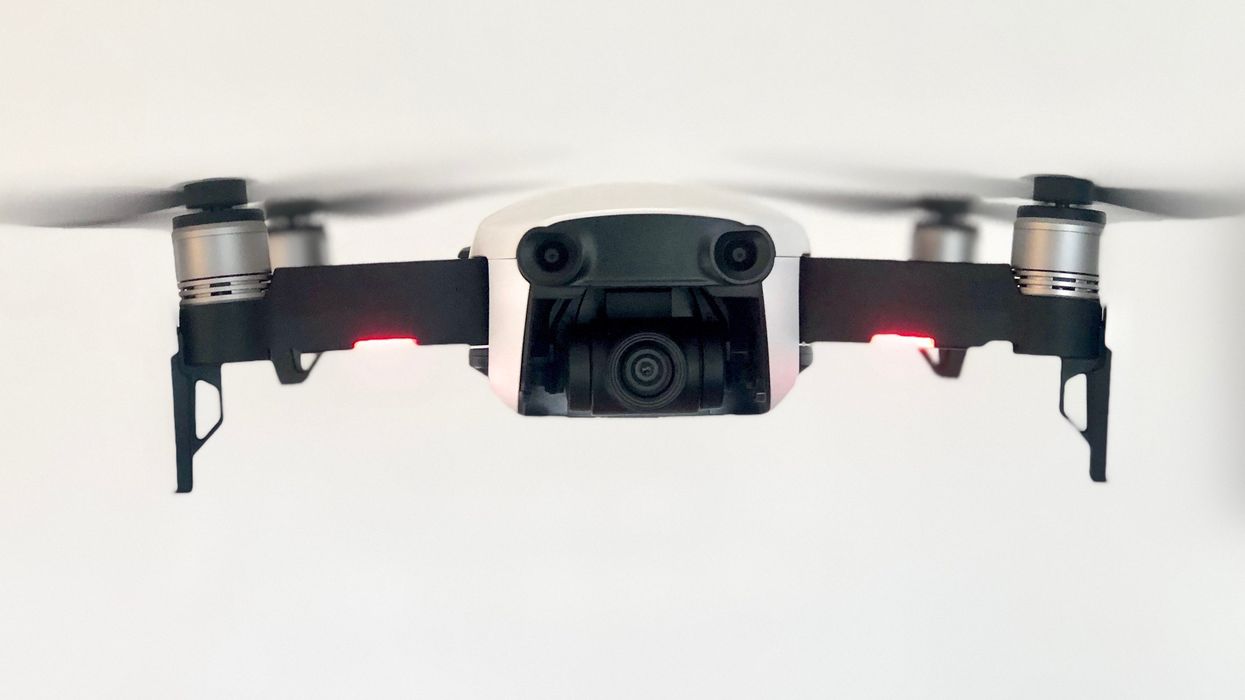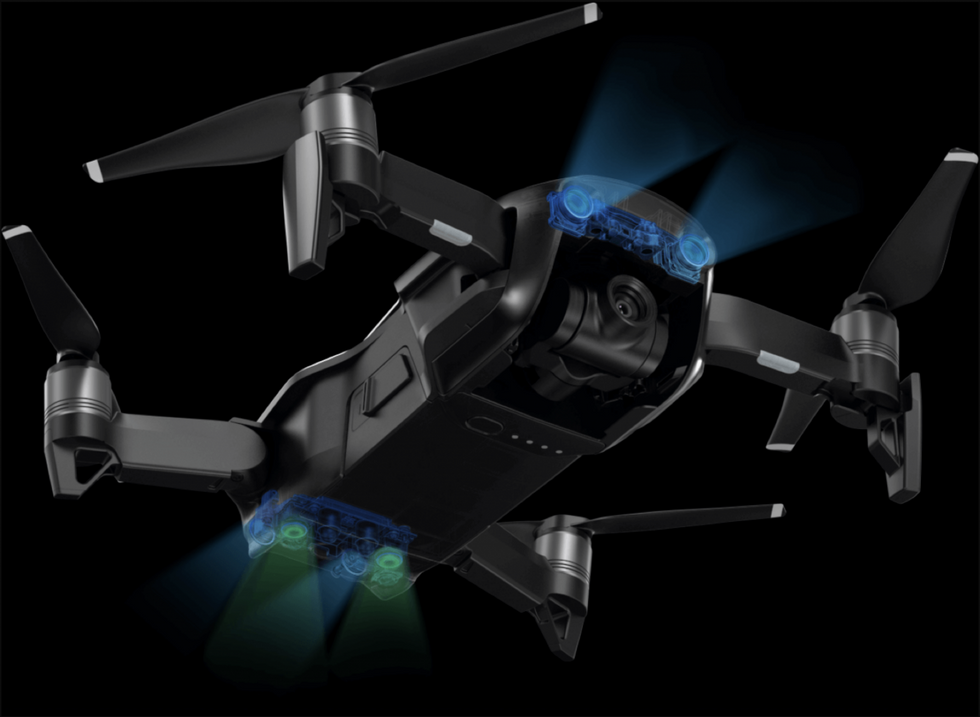REVIEW: DJI Mavic Air Packs a Big Punch in a Small Package
Portability, safety, and creativity are the big features of this little drone.

The Mavic Air is DJI's newest consumer drone designed for enthusiasts & content creators alike who are looking for a highly portable UAV that can shoot stable 4K video and Adobe DNG RAW still photos. DJI sent No Film School a Mavic Air to test out and review, and from our time with the drone, it seems to successfully meet those needs. It also packs in a bunch of sensors to enhance safety, and some autonomous flight modes that make it easy to execute complex flight maneuvers. So without further ado, let's get into it.
Overview
The Mavic Air seems ideal for on-the-go content creators who want to create images that will look great online and who don't have the ability to carry much more than what can fit in a pocket. Can it be used for commercial work? If you're already planning to use footage from action cameras, etc. then the footage from the Mavic Air will blend in just fine. Plus, the tiny drone can create some really unique angles and movements that would be impossible or prohibitive with other tools. Therefore, if the value added by those kinds of shots outweighs the drawbacks of shooting with a small sensor, then that's your answer. Every project is different and you'll need to determine the best tools to use for yours, but if you'd be able to use footage from a GoPro Hero 6, you'll be very happy with the footage from the Mavic Air. While the Mavic Air doesn't have a powerful enough camera for high-end commercial projects, it's portability and ease of use make it a good fit for mobile shooting.
This drone was designed to go with you everywhere.
Design
Despite it's small size, the Mavic Air feels solid and well made. Folding and unfolding the legs inspires confidence that the Mavic Air can handle the rigors of transportation in the pockets and backpacks it was designed to be carried in. It's comfortable to hold in one hand and reinforces the message that this drone was designed to go with you everywhere. The accompanying remote control felt solid. It's about the same size as the Mavic Pro remote and without the addition of an aftermarket bracket, you're limited to previewing on a phone. The drone felt very stable in the air and held up to gusty winds (15-20mph) quite well. The quality of the 4K video and Adobe DNG still photos is about what one would expect from a 1/2.3" sensor and the 100Mbps data rate and global shutter are nice enhancements. A 3-axis gimbal in a space as small as there is on the Mavic Air is unique and helps the drone fit in nicely between the smaller Spark and the larger Mavic Pro.

Image Quality
The Mavic Air has a 1/2.3" sensor which is on par with the size of the sensors found in most other action cameras, but the Mavic Air records 100Mbps at 4K which is substantially higher than other similarly sized cameras. For reference, the GoPro Hero 6 tops out at around 80Mbps in ProTune mode. The Mavic Air also features a global shutter which helps to reduce and eliminate rolling shutter artifacts. This was especially apparent in our tests as I didn't have an ND filter and was shooting in automatic exposure mode. Thus, my shutter speed, at times, was as high as 1/2500. The resulting video certainly has no motion blur, but it is also devoid of rolling shutter artifacts, which certainly helps the overall image quality.
Fringing and chromatic aberration were also minimal and colors looked good, but it would have been nice to have had the option to shoot in D-Log. While the Mavic Air is designed for speed and great looking images straight-out-of-camera and thus the average Mavic Air owner probably wouldn't care much about D-Log, it would still be nice to have had it as an option. Nonetheless, the images did look really good straight out of the drone even despite having shot in Auto Exposure mode with super fast shutter speeds.
DJI has found a way to equip the tiny drone with seven cameras.
Intelligent Flight Modes
The sensor technology and its application are the most impressive feature of DJI's Mavic Air. To make flying as safe and easy as possible, DJI has found a way to equip the tiny drone with seven cameras—including the main image-capturing camera on the 3-axis gimbal—in order to allow the drone to analyze and adapt to its surroundings in real time. With this upgraded sensor system, this is the first Mavic drone to have rear-facing sensors that allow it to avoid obstacles when flying backward as well as forward. In addition, obstacle avoidance has been re-thought. Instead of merely alerting the user to danger or just stopping the drone mid-flight, the Mavic Air features APAS mode which, when turned on, allows the Mavic Air to dynamically adjust its flight path to fly above and around obstacles while the user flies. In cases where the drone can't figure out how to re-route, it will sound a series of warning beeps that get increasingly faster the closer the drone gets to an obstacle. When it reaches minimum distance, the user will not be able to fly any closer toward that obstacle and will have to manually fly around it.
We had the opportunity to test this once at the Mavic Air release event in NYC and again out in the wild while flying for this review. In both cases, the Mavic did a reasonably good job being able to re-route mid-flight. In certain situations, like when the light was changing or when I was flying too quickly, it didn't have time to calculate a flight path and so it alerted me and then stopped before running into anything. Overall, I think it performed well and achieved its main objective of keeping the drone from crashing.
New Quick Shot Modes
Along with improving safety, the DJI Mavic Air puts its sensors and algorithms to creative use. The Mavic Air features two new Quick Shot modes: Boomerang and Asteroid. Boomerang flies a pattern like a tilted ellipse keeping your subject at the center. Asteroid (shown above) takes advantage of what DJI called computational photography which will automatically photograph a 360° spherical panorama, stitch it into a tiny planet and then integrate that with what is essentially a "dronie" shot (where the drone pulls back and away from the subject). I have to say it was pretty incredible that all of that can now happen at the touch of a button from a drone that fits in a jacket pocket.
Conclusions
The DJI Mavic Air is a smart, portable drone that makes it simple for anybody who wants to create eye-catching aerial content. Whether or not it's ease of use and portability outweigh its small sensor is a question that will have to be answered on a per-project basis. Certainly, the image quality doesn't match that of the Phantom 4 Pro and larger sensors but then again, superb image quality isn't what this drone is made for. This drone is made for being able to quickly produce creative photos and videos quickly, safely, and on-the-go and to that end, the Mavic Air succeeds. In terms of compression and frame rate, the Mavic Air actually eclipses the video quality of the Mavic Pro so if you're in the market for a small drone and were looking at the Mavic Pro, I think it's going to be hard not to give the Mavic Air a serious look especially since Mavic Pro costs $200-300 more than the Mavic Air.
Now, can the video quality of the Mavic Air stack up in terms of to a Phantom 4 Pro or any Inspire series drone? In my opinion, no. Would I have a Mavic Air packed with the rest of my kit as an alternate/back up? Absolutely.
The DJI Mavic Air is available at B&H for $799.
Correction: The original post stated that "the Mavic Air is the first DJI drone to have rear-facing sensors that allow it to avoid obstacles when flying backward as well as forward." This was changed for accuracy to "the first Mavic drone to have rear-facing sensors that allow it to avoid obstacles when flying backward as well as forward."











